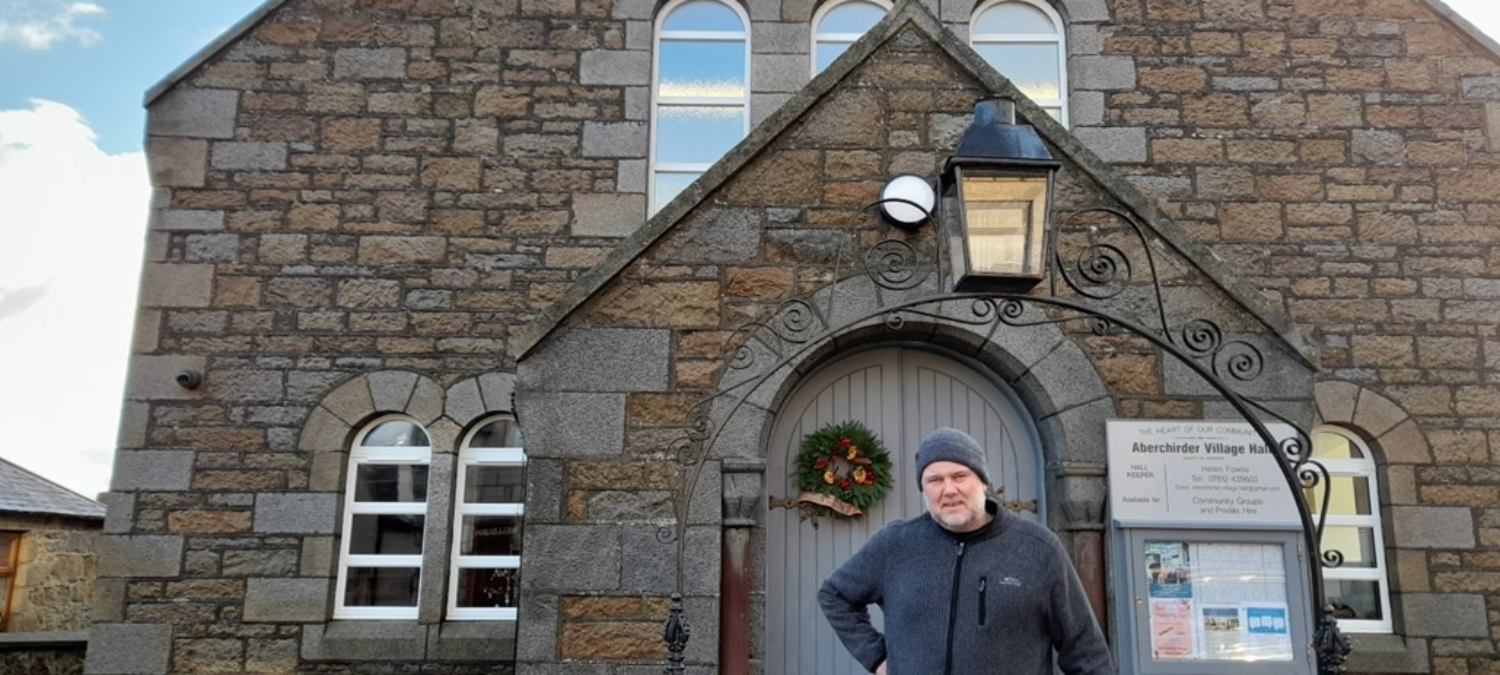
Powering the Community at Aberchirder Village Hall
Generating and storing energy for new carbon saving heating system
Aberchirder Village Hall was awarded £15,000 in 2022 to part fund air source heat pumps, solar PV and battery storage to improve the energy efficiency of the village hall, as part of an overall renovation project aiming to reach net zero for the community building.
The Hall was built in 1898 and serves as a focal point for the local community of Aberchirder, near Huntly. The former Kirk Hall was purchased by the community from the Church of Scotland in 2020. The facility consists of the main hall, two smaller meeting
rooms, and large basement room, along with kitchen and toilet facilities.
The hall had been well used by several local groups prior to the community takeover, but was in need of renovation, modernisation and particularly, energy efficiency improvements. The committee aimed to improve the facilities and attract new visitors and community groups to use the hall on a regular basis.
Some initial work was carried out to install insulation in the roof space within the main hall and the flat roof of the rear extension. Single glazed windows were replaced with modern efficient triple and double-glazed units. The kitchen area had the ceiling lowered by 500mm to allow for the installation of rock wool insulation. These improvements made the hall more comfortable but did not reduce heating bills. The infrared heating remained expensive and difficult to regulate the temperature to hall users’ needs, so AVH wanted to investigate further potential improvements.
The committee arranged for an energy efficiency assessment to be carried out by Zero Waste Scotland in September 2021. This identified two main recommendations: the replacement of the current mix of infrared heat lamps, electric night storage and electric panel heaters with air source heat pumps, and the installation of a photovoltaic array linked to a battery system.
The assessment report estimated that these two recommendations had the potential to save 10.7 tonnes of CO2 per year, with significant associated cost savings. Electricity costs, which are mainly for heating, reached a high of £900 for the month of March 2022 and electricity prices have continued to rise since then.
AVH sought advice and support from CARES and applied for funding through their Let’s Do Net Zero Community Buildings Fund. CARES is the Scottish Government’s Community and Renewable Energy Scheme which supports communities with technical information and grants for renewable energy projects. With funding in place from CARES and Unlock Our Future, AVH were able to install their system of solar panels, battery storage and air source heat pumps in May 2023. They are already finding the new system to be more effective as the warm air from the heat pumps heats the space quickly and efficiently. It is easy to control and they have made a point of explaining how it works to all regular hall user groups. They will have a clearer picture of cost saving after the winter months but expect to have made considerable savings in their energy bills.
As well as the high-tech aspect of the energy generation and storage, they recommend simple measures such as draft proofing for a quick and impactful improvement. They wanted to retain the original wooden door of the hall and have found that installing draft proofing strips and brushes have made it a much more effective barrier to heat loss.
Committee member, Claus Nielsen, said:
The whole process has been very time consuming and at times stressful. It’s not easy to make a 125-year-old building a “Net Zero-Energy (NZE) building” - meaning the total amount of energy used by the building on an annual basis is equal to the amount of renewable energy created on the site. But thanks to Vattenfall and CARES we managed to add insulation, double/triple glazed windows, draft proof doors, new heating system combined with solar panels and battery storage see our village hall well on the way to achieve this. On a normal day with a mix of clouds and sunshine our PV system manage to create more than 10kwh and only 131w was imported from the grid.




